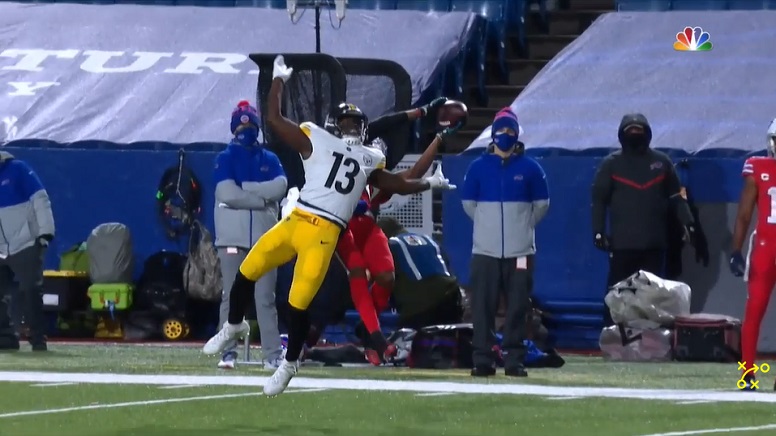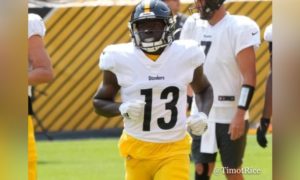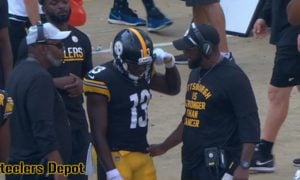One of the most common things you hear after every draft is that grades can’t be finished until at least three years after a pick has been made. So after submitting my grades for every Steelers’ pick in this year’s class, I’m going back and revisiting picks from three years ago and beyond made by Pittsburgh. That continues today with the team’s second-round pick in 2018, wide receiver James Washington out of Oklahoma State.
I tweaked my exercise for grading this year’s draft to look at and give letter grades to past picks, based on five specific ways to view the pick (listed below), before taking all that analysis and combining it into a final letter grade. Those five viewpoints comprise much of what goes into the draft grades consumed by so many every year after the draft.
Steelers’ Career: What did the player contribute to the team that drafted him?
NFL Career: Did the player make the pick look better in hindsight after leaving Pittsburgh?
Pick Value: Did the player outperform his draft slot? Did he fail to live up to the pick used on him?
Positional Value: Was the player the best player remaining at his specific position in the draft?
Other Options: Did any players go during the next round that were better selections?
Overall Grade: A final mark to denote whether the selection was an overall positive one, or one that could’ve been better spent elsewhere.
Just like when grading a current year’s draft, each factor in a retrospective doesn’t apply evenly to every pick made. For example, a first round selection should have a longer and more impactful career, whereas a late-round pick only needs a few seasons in a limited role to live up to his draft slot.
Some factors are universal, though. Whether picked first overall or 259th, there will always be other options on the board to compare the player to, and steals and reaches can come from any place in the draft.
Round 2, Pick 60: James Washington, WR, Oklahoma State
STEELERS & NFL CAREER: C
Washington has had an absolute gauntlet of competition to fight through his entire career. Pittsburgh drafted him onto a team that had Antonio Brown and JuJu Smith-Schuster, then added Diontae Johnson one draft and Chase Claypool the next. The constant influx of new, talented receivers has kept Washington fighting for the best spot he can get in the WR2-4 range, behind first Brown and then Smith-Schuster on the depth chart.
Washington, though, has failed to outperform his competition despite his status as the elder stateman among the new faces. Johnson quickly supplanted him as the better starting option to assist the Mason Rudolph/Devlin Hodges pairing at quarterback. Then Claypool’s breakout in 2020 dumped Washington to No. 4 on the depth chart. With all three back in the fold, Washington seems firmly locked into that spot again in 2021.
He’s had a solid career in the snaps he has received on the field.
A line of 44 receptions, 735 yards, and three touchdowns in 2019 is a good performance, given his splitting targets with JuJu and Johnson, and the horrendous QB play he worked with once Ben Roethlisberger was injured. He has also started at least six games every season, and played in 46. But a career line of 90 receptions, 1,344 yards, and nine touchdowns is underwhelming even for a No. 3 receiver on a team that has liked to pass as much as the Steelers. The constant competition hasn’t done him any favors, but neither has his inability to earn a higher spot in the pecking order.
PICK VALUE: C
At the time, Washington’s selection was viewed as a strong one for the Steelers. His deep threat ability and outstanding production at Oklahoma State had many excited to see what he could do to replace Martavis Bryant in the team’s offense. Pittsburgh traded Bryant earlier that day to the Raiders.
But drafted with Bryant’s role waiting for him, Washington has not lived up to the 60th pick used on him. You don’t necessarily need a guaranteed No. 1 or 2 receiver when you draft one in the late second. But you at least want a consistent contributor and something closer to a starter than a depth option at any position you draft in the second, and Washington hasn’t been that. He earns some of the blame. But some also needs directed at his usage in the team’s offense, which was not as aggressive early on as it could have been.
POSITIONAL VALUE: C
A lot of receivers selected in the picks after Washington have earned longer-term NFL careers, or at least second contracts. Helping Washington’s case is that while many have become contributors, few have become starters and clearly better options than him at receiver. Two names stick out as exceptions, though. One is the player who went on the very next pick: D.J. Chark of Jacksonville. And the other is the receiver taken after him, Michael Gallup, 81st overall to Dallas.
Chark has had a similar career progression to Washington. Under-used first season, career-best second season, regressed third season. But in his 2019 year, he made the Pro Bowl and looked the part of a No. 1 or 2 receiver, topping 1,000 yards with eight touchdowns. Even his 2020 was a strong year, with 706 yards while missing three games.
Gallup is the miss that really hits the grade here, though. After a 500-yard rookie year, he went for 1,107 yards in 2019 while missing two games, and had 843 yards in 2020 while earning his place as one of the NFL’s best deep threats. Gallup essentially has become the deep threat No. 3 WR in Dallas that Pittsburgh drafted Washington to be.
Other names to earn contributing or depth NFL roles are Tre’Quan Smith (New Orleans), Keke Coutee (Houston), Marquez Valdez-Scantling (Green Bay), Russell Gage (Atlanta), Braxton Berrios (New York Jets), and Auden Tate (Cincinnati). Washington is a better option than all of them if you’re redoing pick 60. But a player going 20 picks later and filling the exact role Washington failed to hurts.
OTHER OPTIONS: D+
Gallup and Chark came within the next 32 picks, so they stand as better choices for this pick. Starting to shift to more of a best player available approach, a bunch of other names crop up. Brian O’Neill has become a dependable starter at tackle in Minnesota. Carlton Davis, mentioned in yesterday’s re-grade of Terrell Edmunds, went three picks later and is an outstanding corner now for Tampa Bay.
Keeping in strictly within the next 32 picks, one more name stands out: Fred Warner. Going 70th to San Francisco, Warner in three years has become one of the elite linebackers in the game, with over 110 tackles every season, five forced fumbles, three recovered, three interceptions, and an All-Pro nod in 2020. For a team that had just lost Ryan Shazier, Warner was a perfect replacement and an instant A+ selection. His name alone drops this grade plenty. Adding in the missed chance on Gallup or Chark, and it gets worse.
OVERALL GRADE: C-
Between not using him as much as they should have early, to using Day 2 picks at the position each of the next two drafts, Pittsburgh gave Washington longer odds than most second-round picks of becoming a long-term contributor. But Washington had chances to hold off both Diontae Johnson and Chase Claypool, and didn’t retain his spot as a top-three target on the team.
This is a pick that looked great at the time coming off the Martavis Bryant trade. And Washington still retains the promise of a second-round pick and deep threat contributor to an offense. But this was a missed selection, that only compounds when you see how the next two receivers off the board produced in roles Washington was supposed to fill for the Steelers, as well as an All-Pro linebacker that went shortly after that would have erased one of the team’s biggest needs both then and in the coming offseasons.






